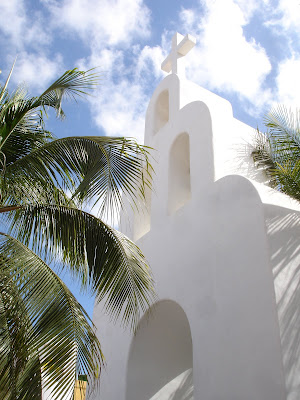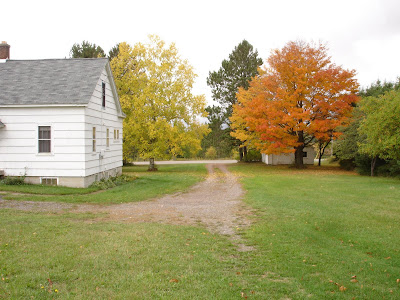I grew up in a white house, that never changed color. That post-war Cape-Cod-esque house was sided with aluminum. “We never need to paint,” was my mother’s victory cry when she bought the house. Of course years later my step-father went after it with a hose and a brush. Not to change it but to keep it white.
White happens to be the most popular paint color in America, both for interiors and exteriors. Most paint companies have a wider range of whites than any other color. There are even paint companies that produce only white paints. So there are alot of white houses out there.White houses are by far not my favorite. I seems ironic, or at least odd, that I keep landing in white houses. Of course the odds are good.
Back when I was living in that white house on 65th Street in Milwaukee, I took a trip with a school group to our nation’s capital. Washington, D.C., as you know is the home of the most famous white house, the White House. It is also home to innumerable other white buildings. Mostly neoclassical behemoths paying tribute to the birth place of Democracy, Greece. As a 13 year old I had no ideas about politics, history or government. These bone white structures left me cold. I was more interested in the dinosaur bones in the Smithsonian.
Twenty years later I travelled to Greece. I was much more taken with the Byzantine churches and monasteries than the tumbled down Classical World. When I found out that the Acropolis was closed due to strikes, it didn’t mar my visit to Athens at all. I even went to the movies, an American movie, when I was there. Yet each day when I left my hotel I could see the Acropolis between some high rise apartments. Its looming appearance from all over town became enough. Enough all ready. Every where little replicas of the Parthenon for sale, metal, marble and resin replicas. Finally, on my last day in town, when I was in the Agora sampling yet another feta (a very white cheese, I might add) I heard some tourists talking. The acropolis was open. Only for 4 hours that afternoon. No explanation. I was spending way to long in Athens according to the guide books. I was trying not to be a tourist. Sitting in little neighborhood parks just day dreaming. But suddenly I wanted to get caught up in the fury. I ran to the bus, that took me to the base of the hill on which this Unesco World Heritage site stood. I had been being teased and acting disinterested ever since I arrived in Athens. Now that access was granted I was running.
It was late October, I don’t know if the benign weather, the late day sun or the lack of tourists were all that were at play, but the Acropolis was luminous.
I was floored.
It was not only monumental but sublime. All the architecture that had echoed off of it over the millennia seemed a sham. I imagined how celestial this place must have seemed with the wise and newly democratic Greeks wandering about in their seamless white draperies. But wait, that brilliant marble was painted. Garishly so. One scientist even speculates the Parthenon was painted red, white and blue. But at the time none of that knowledge marred the few hours I got to spend in total white rapture.
I was not so lucky when I travelled to India twenty years after that. The day I was going to catch the train to Agra to see the Taj Mahal, that other monument to white architecture, I came down with a severe case of amoebic dysentery. I barely left my room , let alone the compound of the dargah of Hazrat Inayat Khan.

The only white building I would see for that week was this small mosque outside my door. Not the most splendid mosque in the Nizamuddin ghetto of New Delhi it may seem strange the impact it had on me. But it became my clock and calendar, even a barometer, as it’s white dome changed color from sunrise to sunset, carried the shadows of clouds or was plunged into darkness when the electricity was shut off in the neighborhood each night. It became the moon in the night, full with whatever ambient light it could catch. Since I was sleepless I would sit on a little chair outside my door, and in a dehydrated revery watch it rise from the darkness.

White is a very common color for houses of worship as well as homes. Think of the white chapels cluttering the American countryside. In Playa del Carmen, Mexico the steeple of this church raised our eyes from the bubbling colorful commerce of that tourist town, and toward the blue sky. That’s why we came so far south in February after all. Not to shop.

The Shakers did not shrink from painting buildings red, especially workshops and barns. But their dormitories and meeting houses were always a puritanical white. This meeting hall in New Lebanon, New York has the same moon-ascending quality as the little mosque outside my room in Delhi.

I took this picture from the top of the leaning tower on a winter afternoon in Pisa, looking west over the Duomo di Santa Maria Assunta. This cathedral; along with the other buildings of the Campo dei Miracoli, can blush like a school girl at sunset, but was sullen and ashen as a corpse under the low gray skies of March.

Augustine Hope, the co-author of The Color Compendium writes about the last century, “ I don’t think another century has its own color, but this one does. And that is white. White before this century was a luxury.” When I think of all the refridgerators, not to mention the billion or so other appliances, I can agree, the 20th century is white.White is modern and no one knew that better than the Bauhaus Group. They ushered in a rage for all things white in the early 30s. Maybe a reaction to the gloomy Great Depression? In this apartment house in Berlin the flatness of the white facade and the serious symmetry breaks into joy with the brightly colored door and windows. Once again white responding to its surrounding.

The interior of the entrance hall of the new wing of the Milwaukee Art Museum, not far from that 65th Street house where I grew up. This was Spanish architect, Santiago Calatrava’s first American project. Bauhaus member Johannes Itten said “form and color are one”, as far as the architecture of Calatrava is concerned I couldn’t agree more. His elegant air born buildings would look foolish in any thing but white.

The Marie-Elisabeth-Lueders-Haus, part of the modern government complex at the center of the reunified Berlin though modern in form has the beauty of ancient marble. The concrete surfaces were coated with a multifunctional scumble, a glaze for concrete and stone.

But all white buildings are not monuments, holy places or government building. More often they are homes. This small white house was built by my step-father and his father back in the 40s. I now belongs to my sister and I can’t imagine it being anything but white.

Even this humble little Mayan hut in Ekbalam, Mexico has a dignifying coat of white paint. Or maybe it’s just a practical heat deflecting coat of white paint.

Then there is home-sweet-home, white as sugar. Where I sleep and eat.
Where I write from.
Where the only monument, the only holy site, the only governance comes from a pale blue sky smeared with white clouds.